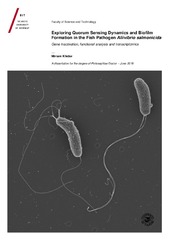Characterization of competition between commensal and clinical strains of Enterococcus faecium
Permanent link
https://hdl.handle.net/10037/29322Date
2021-06-01Type
Master thesisMastergradsoppgave
Author
Engi, DanielAbstract
Invasive infection by multidrug-resistant Enterococcus faecium is increasingly becoming a healthcare concern. Few studies have addressed whether and how clinical E. faecium strains are able to outcompete commensal strains. This thesis aimed to characterize the in vitro competition between commensal and clinical E. faecium strains with respect to growth inhibition exerted by bacteriocins produced by the respective strain groups. A combination of laboratory assays and bioinformatical methods were applied toward this goal. Laboratory assays consisted of competitively growing commensal and clinical E. faecium strains, and using unmodified and modified supernatants from the same strains to investigate the nature of growth inhibition-mediating agents. The bioinformatical methods consisted of genetic relationship analyses and ribosomally synthesized post-translationally modified peptide-mining. It was shown that clinical E. faecium strains generally outcompete commensal E. faecium strains in vitro, though the commensal E. faecium strains that inhibit the growth of clinical E. faecium strains most often, do so very strongly. Furthermore, some commensal and clinical E. faecium strains possibly encoding novel bacteriocins were identified. Finally some commensal E. faecium strains that were resistant to the growth-inhibiting mechanisms of most epidemic and hospital-associated clinical E. faecium strains were found.
Publisher
UiT Norges arktiske universitetUiT The Arctic University of Norway
Metadata
Show full item recordCollections
- Mastergradsoppgaver Helsefak [1337]
Copyright 2021 The Author(s)
The following license file are associated with this item:
Except where otherwise noted, this item's license is described as Attribution-NonCommercial-ShareAlike 4.0 International (CC BY-NC-SA 4.0)
Related items
Showing items related by title, author, creator and subject.
-
Gut metagenomics in relation to diet and methanogenesis in arctic herbivores
Salgado, Alejandro Flores (Doctoral thesis; Doktorgradsavhandling, 2017-06-01)Enteric methane (CH4) from gut microbial fermentation of complex organic polymers in ruminants comprises an important source of the anthropogenic CH4 emissions and may also represent a significant loss of metabolic energy to the host animal depending on diet. CH4 is produced by specialized microbes called methanogens. Extensive research exists on enteric CH4 production and methanogens in domestic ... -
Shifts in bacterial biodiversity along an environmental gradient in high-Arctic tundra
Düring, Aslak von (Master thesis; Mastergradsoppgave, 2019-11-18)Arctic soil microbiomes may have to face drastic climate changes in the coming century. Currently, the arctic tundra act as a carbon sink due to slow decomposition rates of soil organic carbon, which partly owes to low temperatures and poor water drainage. However, with elevated temperatures, large, latent carbon pools stored in arctic permafrost are exposed to mineralization by the active layer ... -
Exploring Quorum Sensing Dynamics and Biofilm Formation in the Fish Pathogen Aliivibrio salmonicida
Khider, Miriam (Doctoral thesis; Doktorgradsavhandling, 2019-10-22)<p>The marine pathogen <i>Aliivibrio salmonicida</i> is the causative agent of cold-water vibriosis, affecting mainly farmed salmonid fish when water temperatures are below 10°C. Even though cold-water vibriosis is no longer threatening Norwegian aquaculture, the reemergence of the disease is still a possibility. Therefore, it is crucial to gain knowledge and understanding of the pathogenicity ...


 English
English norsk
norsk



